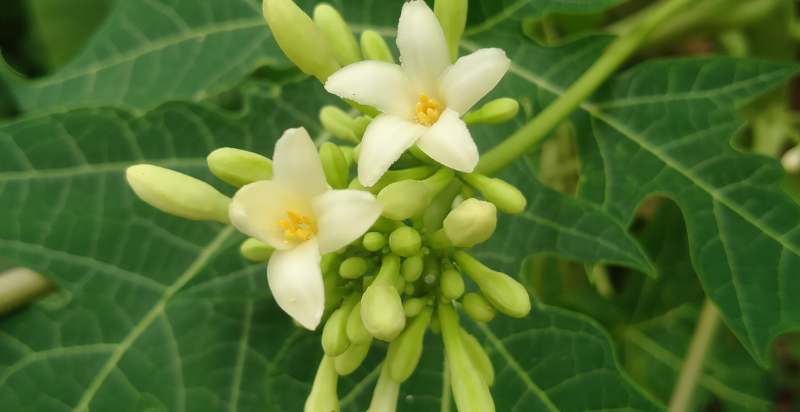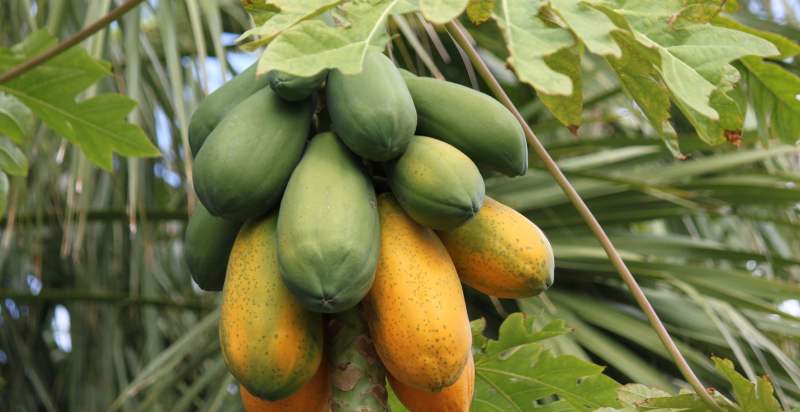Papayas are one of the most popular fruits in the world. Native to Central America, they are now grown in tropical regions all over the globe. In addition to being delicious, papayas are a great source of vitamins A, C, and E.
Papayas are relatively easy to grow and are a great addition to any home garden. This article will show you everything you need to know about how to plant, grow, care for, and harvest papaya trees.
What is Papaya?
The papaya tree is the largest herbaceous plant in the world. Growing to a height of 10 meters (33 ft), the papaya is an unbranched tree with a single trunk crowned by a head of leaves. It is believed that the papaya originated in Central America and was introduced to India, the Philippines, and southern China by Portuguese sailors in the 16th century. The scientific name for the papaya is Carica papaya L. It belongs to the family Caricaceae.
There are three types of papayas – Hawaiian, Mexican, and Maradol. The Hawaiian variety is relatively small, with fruits weighing around 0.5 kg (1 lb). The Mexican variety is larger, with fruits weighing 1-2 kg (2-4 lb). The Maradol papaya is the largest, with fruits weighing up to 4 kg (9 lb).
The papaya tree bears large, fleshy, oval, or spherical fruits. The fruit is yellowish-orange in color and has black seeds in the center. The fruit’s soft, sweet flesh can be consumed raw or added to smoothies, juices, and other dishes.
Papayas are a great source of dietary fiber, vitamins A and C, and both. They also contain enzymes that help with digestion. Papayas are low in calories and fat, making them a healthy addition to any diet.
How to Plant, Grow, Care, and Harvest Papayas?
Papaya trees are relatively easy to grow and can be started from seed. They prefer warm, humid climates and well-drained soil. Papayas should be fertilized regularly, and the fruits should be harvested when they are ripe. If you’re looking for a delicious, healthy fruit to add to your diet, papayas are a great choice.
When to Plant Papaya Trees:
Papaya trees are fast growers and can be planted at any time of year in frost-free areas. The best time to plant them is in the spring when the weather is warm, and the risk of frost has passed. If you live in an area with a lot of rainfall, it’s best to wait until the rainy season is over before planting your it. This will help to prevent the roots from rotting.
Where to Plant Papaya Trees:
Papaya trees are tropical plants that thrive in warm, humid climates. They can be planted outdoors in areas that receive full sun and have well-drained soil. If you live in a colder climate, you can grow papaya trees in containers and bring them inside during winter. When planting papaya trees, it’s important to space them at least 10 feet apart so that they have room to grow.
How to Plant Papaya Trees:
Papaya trees can be started from seed or propagated from cuttings.
If starting your papaya tree from seed, plant the seeds in a pot filled with a well-drained potting mix. Place the pot somewhere warm and sunny, and hydrate the soil. In two to three weeks, the seeds will begin to sprout.
Transplant the seedlings into potting mixes with good drainage after they have emerged. The seedlings can be transplanted into their permanent spot in the garden once they reach a height of six inches.
To propagate papaya trees from cuttings:
- Cut from a healthy papaya tree at least six inches long.
- Wrap the cutting in a damp paper towel and place it in a plastic bag.
- Put the bag in a warm, sunny location and wait for the roots to develop. This can take four to six weeks.
- Once the roots have developed, transplant the cutting into a pot filled with a well-drained potting mix. When the cutting is six inches tall, it can be transplanted into its permanent location in the garden.

Care For Papaya Trees:
Papaya trees are relatively easy to take care of, especially compared to other fruit trees. They require little pruning and can tolerate various soil types and climates. However, it would help if you kept a few things in mind when caring for your papaya tree to ensure it remains healthy and produces plenty of fruit.
Watering is the most important aspect of papaya tree care. These trees are native to tropical climates and require consistent moisture to produce fruit. During the fruiting season, water your papaya tree at least once a week, providing enough water to soak the root zone thoroughly. Your tree can require more frequent watering if you reside in a region with little rainfall.
These are relatively tolerant of poor soil conditions, but they will produce the best fruit in well-drained, nutrient-rich soil. If your soil is sandy or clay-like, mix in some organic matter to improve drainage and aeration. To aid in retaining moisture, you can also spread a layer of mulch around the tree’s base.
For a papaya tree to grow healthily and bear fruit, fertilisation is essential. Use a balanced fertilizer formulated for fruit trees and apply it according to the package directions. For best results, fertilize your papaya tree three times a year – once in spring, summer, and fall.
Papaya trees don’t usually need pruning, but you might want to cut off any dead or sickly branches as soon as you see them. You can also prune away any suckers that develop around the tree’s base. These small shoots sprout from the roots and compete with the main trunk for water and nutrients.
Papaya trees are relatively disease- and pest-resistant, but they can occasionally be affected by problems such as scale, mealybugs, or aphids. If you notice any of these pests on your tree, treat the problem immediately with an organic pesticide.
Your papaya tree will thrive and produce abundant sweet fruit with proper care. Enjoy fresh homegrown papayas or use them in smoothies, salads, or other recipes.

Harvesting Papaya Trees:
Papaya trees are generally ready to be harvested when the fruit is fully ripened. A few different methods can determine this. One is to observe the color of the skin of the papaya fruit. It is usually time to harvest when it is mostly yellow or even orange. Another way to tell if a papaya is ripe is to press the skin near the stem gently.
If it yields to pressure, it is probably ripe and ready for harvesting. Finally, ripe papayas typically have a sweet smell. When these indicators are present, it is time to harvest your papaya crop!
To harvest the fruits, cut them from the tree with a sharp knife or pruning shears. Be careful not to damage the tree in the process. Once the papayas are harvested, they can be eaten fresh or used in various recipes. Enjoy your delicious papayas!

How To Store Grown Papayas ?
After harvesting, choose a cool, dry place to store your papayas. Choose for an area with good ventilation to prevent the fruit from rotting. If you plan to eat the papaya within a week, you can leave it on the counter at room temperature. Otherwise, store it in the fridge for up to two weeks. In the refrigerator, cut papayas can be kept for up to four days in an airtight container.
Papayas can also be frozen for long-term storage. First, wash and cut the fruit into small pieces. Then, cover the papaya pieces with parchment paper and freeze them for two to three hours. Transfer them to a freezer-safe bag or container once they are completely frozen. Papayas can be stored frozen for up to six months.
They should be defrosted either overnight in the refrigerator or briefly in a basin of warm water before eating. Then you may eat it straight away or incorporate it into your preferred recipe.

Conclusion
Papaya trees are relatively easy to care for and can provide an abundance of delicious fruit. Your papaya tree will thrive with proper watering, fertilizing, and pruning. Enjoy fresh homegrown papayas or use them in smoothies, salads, or other recipes. Store any extra papayas in the fridge
- Everything You Wanted to Know About Red Tamarillos - June 2, 2025
- A Guide to Tulips: Everything You Need to Know & More… - June 2, 2025
- Guanabana: Description, Flavor, Benefits, And Uses - May 27, 2025

4 thoughts on “Papaya Tree: How to Plant, Grow, Care and Harvest Papaya”
Comments are closed.